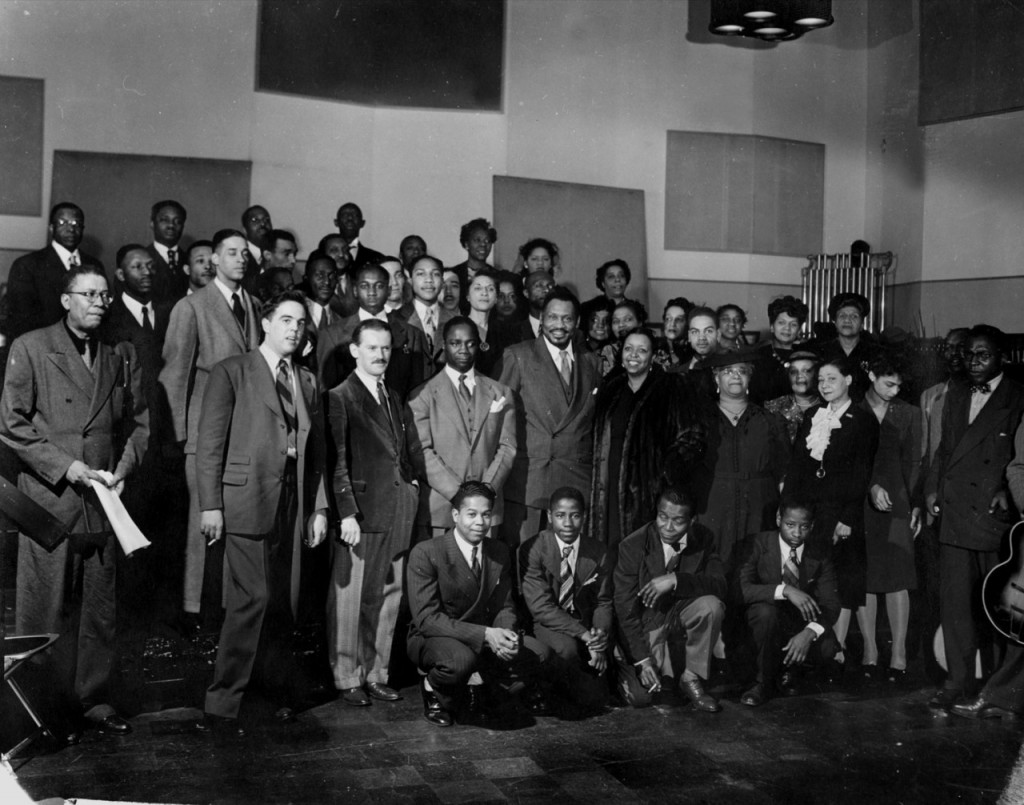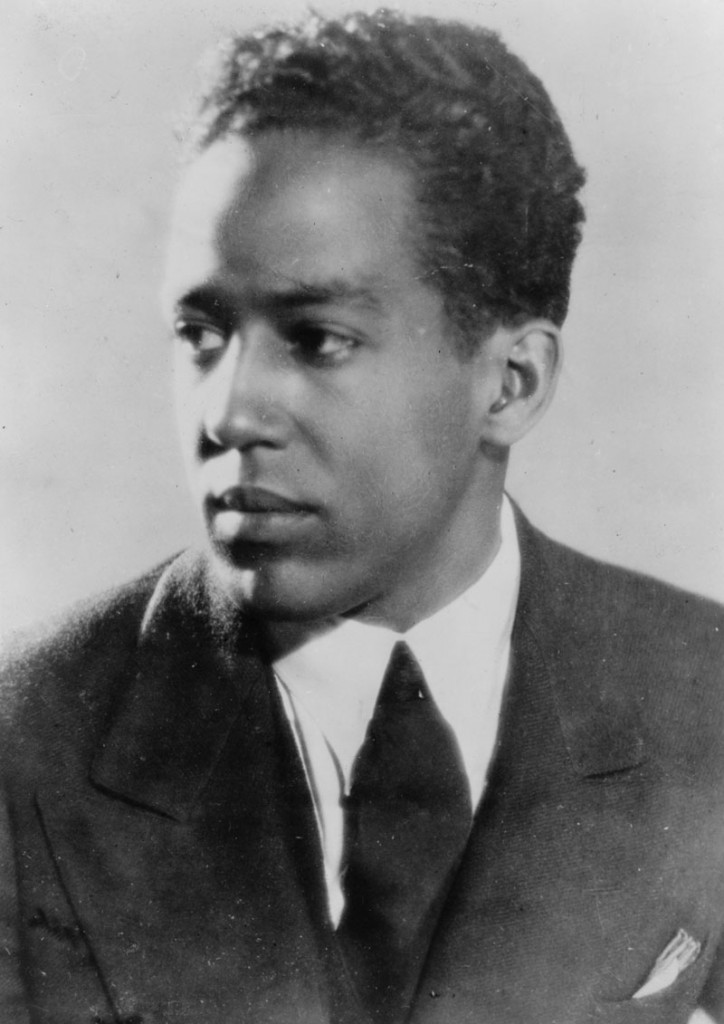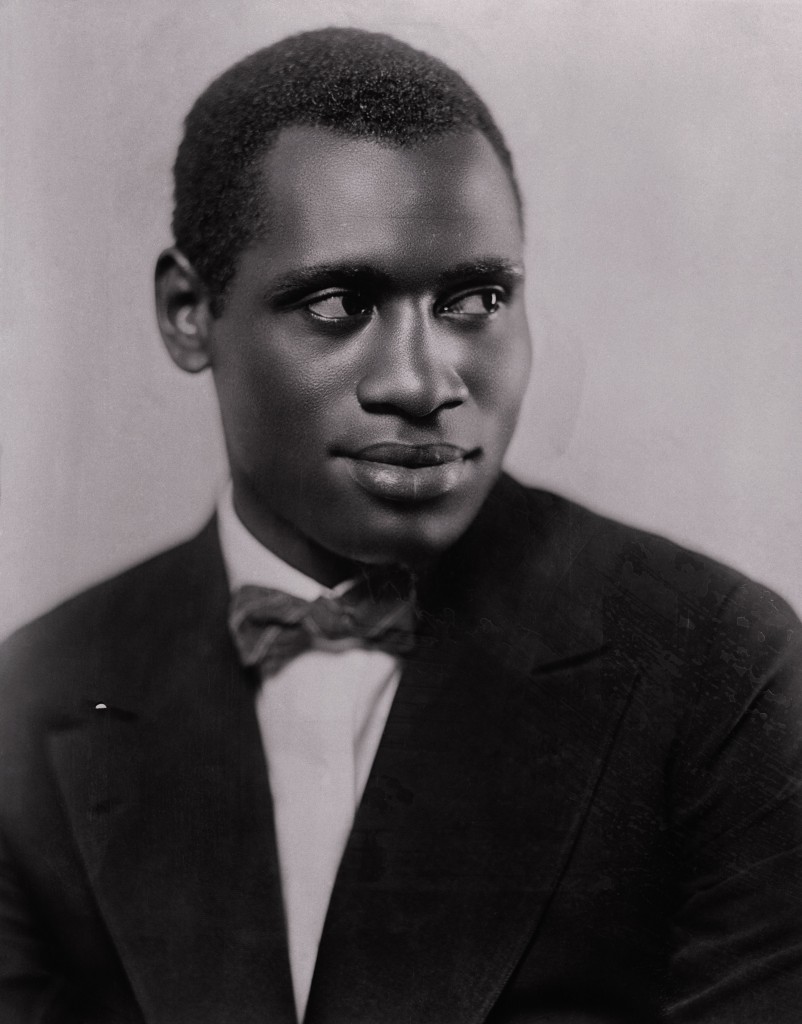Missing from History: Langston Hughes’ The Man Who Went To War

Front row standing (L-R): Hall Johnson, Alan Lomax, D. G. Bridson, Canada Lee, Paul Robeson, Ethel Waters.
Post by Michele Hilmes, University of Wisconsin-Madison
I have been so overwhelmed, and humbled, by the recent sequence of posts here on Antenna, sparked by the wonderful podcast assembled by Andrew Bottomley, Jeremy Morris, and Christopher Cwynar, that I wanted first of all to thank all of you who cast so many kind words in my direction, and second to say something about what I’ll be getting up to in retirement.
It was especially gratifying to hear so many of you acknowledge the importance of an historical perspective on the present, to enable us to see it more clearly. This works the other way too: to paraphrase Foucault, the perspective of the present continuously helps us to see things that were obscured in the past, such as the agency of whole classes of people – women, minorities, those outside the mainstream’s scope – as well as the significance of work done long ago and forgotten but now finding new relevance as we push the borders of our field ever wider.
One example of this in the field of sound is the first ever collection of critical essays on the creative work of Norman Corwin forthcoming from California in the spring, edited by Neil Verma with contributions from many of you reading this. It took a new generation of media scholarship, combined with the new interest in sound sparked by the digital present, to enable us once again to perceive the value of Corwin’s innovations, so long unheard and unappreciated.

Langston Hughes
Another example involves one of those amazingly serendipitous archival stories we sometimes get to tell. About five years ago, I was at the Library of Congress following up on research for Network Nations. One thing I was looking for was any trace of some of the radio features produced in the US during the WWII years by D. G. Bridson, an important innovator of the radio documentary feature form at the BBC. In his biography, Prospero and Ariel, Bridson describes his experiences working with people like Alan Lomax and Langston Hughes, the premier poet of the Harlem Renaissance, whom Bridson commissioned in late 1943 to write an original “ballad opera” in support of the war effort.[1]
Hughes’ script of The Man Who Went To War was produced in New York in February 1944, featuring some of the most significant African-American performers of the era. Paul Robeson introduced the show and provided the “Voice of God” at the end; Josh White performed the sung narration, with Ethel Waters and Canada Lee playing the central roles of Sally and Johnny. Alan Lomax arranged the music, which was sung by the Hall Johnson Choir, accompanied by noted bluesmen Sonny Terry playing harmonica and Brownie McGhee on guitar.
Hughes, whose struggle to get his scripts on the air in the US had led to frustration and disappointment, wrote to Erik Barnouw in March 1945:
“Probably my best script is THE MAN WHO WENT TO WAR as performed on BBC for England and the colonies last spring…Considering the seriousness of the race problem in our country, I do not feel that radio is serving the public interest in that regard very well… Personally, I DO NOT LIKE RADIO, and I feel that it is almost as far from being a free medium of expression for Negro writers as Hitler’s airlanes are for the Jews.”[2]
Hughes’ answer to US radio’s silence on race was to construct a musical drama that simply refuses to acknowledge that African-American and British identity might not be thoroughly elidable, or that the language of blues and gospel music might not speak for “all freedom-loving people,” without distinction. More musical poetry than drama, Hughes and Bridson built on the “radio ballad” or “ballad opera” form pioneered by Alan Lomax in the US and later developed by Charles Parker in Britain.
Listen here to the opening sequence of The Man Who Went to War:

Paul Robeson
The show was never aired in the US, due to rights issues, but was recorded and broadcast over the BBC in the spring of 1944, with highly favorable reception. But here, according to Bridson, its story ends; the last remaining recording – made on glass discs – was shattered soon after. And thus faded The Man Who Went To War, one of the very few of Hughes’ scripts for radio actually broadcast, unheard by the American public and inaccessible to scholars.
But not so! As I found out that day in 2010, the Library of Congress amazingly preserved a recorded copy – not the best sound quality in places, faded and scratched, but bringing to human ears for the first time in more than six decades voices and performances unique to the historical radio soundscape. It has now been digitized and can be found in the LOC collection, though not alas online. I look forward not only to digging into the history and reception of this unique work, but to making it the centerpiece of a history of the radio feature in the United States – the creative tradition that underlies current innovative soundwork like This American Life and Serial but that, like Corwin and so much else in American radio, remains missing from history – until media scholars like us go looking.
Thanks to the field we have together built up, and thanks too to some important historical projects you’ve read about here – the Radio Preservation Task Force, the Archive of American Public Broadcasting, and others in progress – much more of our missing media history promises to be revealed, after decades of silence. It is my hope, and a goal in retirement, that what I have elsewhere referred to as the “lost critical history of radio”[3] – and by that I mean the critical heritage of American soundwork, in particular – can be revived and made meaningful to those of us who create, listen to, and reflect on soundwork today.
______________
[1] My grateful thanks to Lisa Hollenbach for sharing with me her research in Langston Hughes’ papers in Yale’s Beinecke Collection.
[2] Letter from Langston Hughes to Erik Barnouw, 27 March 1945. B1 F10, Erik Barnouw papers, Columbia University.
[3] Michele Hilmes, “Radio’s Lost Critical History,” Australian Journalism Review Special Edition “Radio Reinvented: the enduring appeal of audio in the digital age,” 36:2, Spring 2015.


